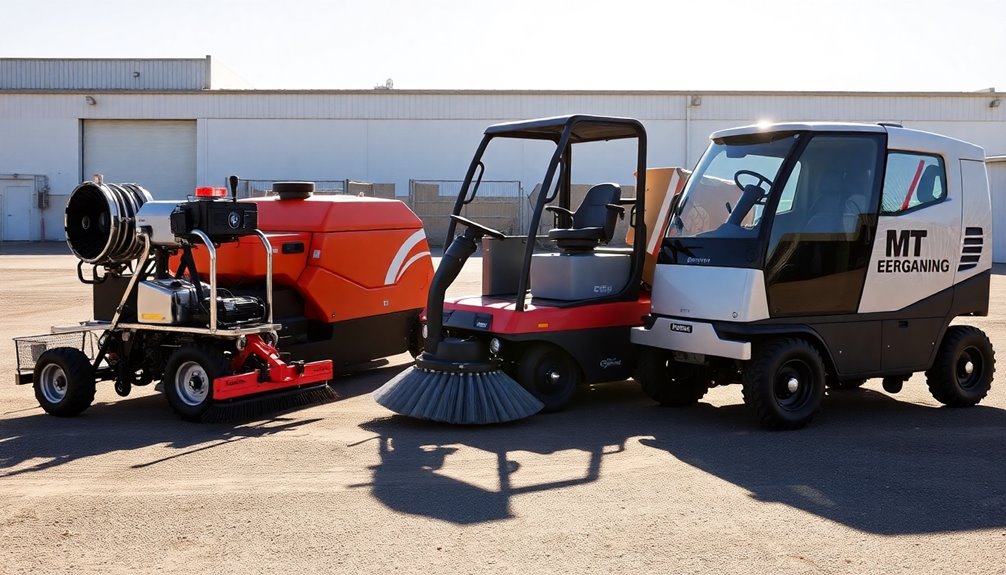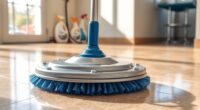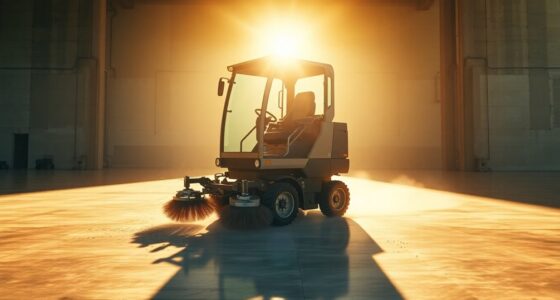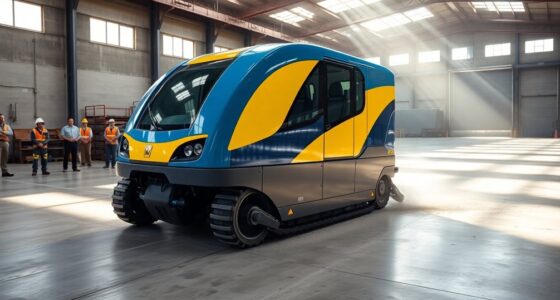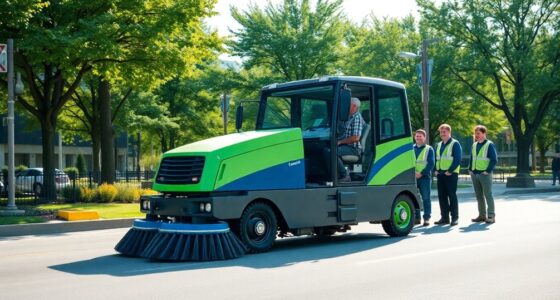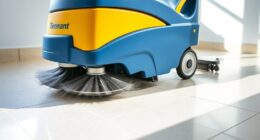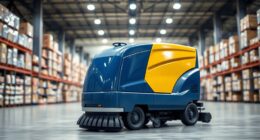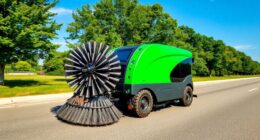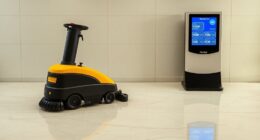Understanding the different models of commercial sweepers starts with recognizing the two main types: walk-behind and ride-on. Walk-behind sweepers are great for smaller spaces under 4,000 sq. ft., while ride-on models excel in larger areas like warehouses. Each type has unique features such as power sources—battery or gas—and different cleaning mechanisms that affect efficiency. By knowing these distinctions, you can find the right sweeper that fits your specific cleaning needs and uncover more helpful insights.
Key Takeaways
- Commercial sweepers are primarily categorized into walk-behind and ride-on models, each suited for different space sizes.
- Walk-behind sweepers are ideal for areas under 4,000 sq. ft., offering maneuverability and cost-effectiveness.
- Ride-on sweepers excel in larger spaces with higher debris capacity and advanced cleaning mechanisms for enhanced efficiency.
- Power sources include battery-powered, electric, and gas-powered options, impacting noise levels and environmental considerations.
- Regular maintenance is crucial for both types of sweepers to ensure optimal performance and longevity.
Overview of Commercial Sweepers
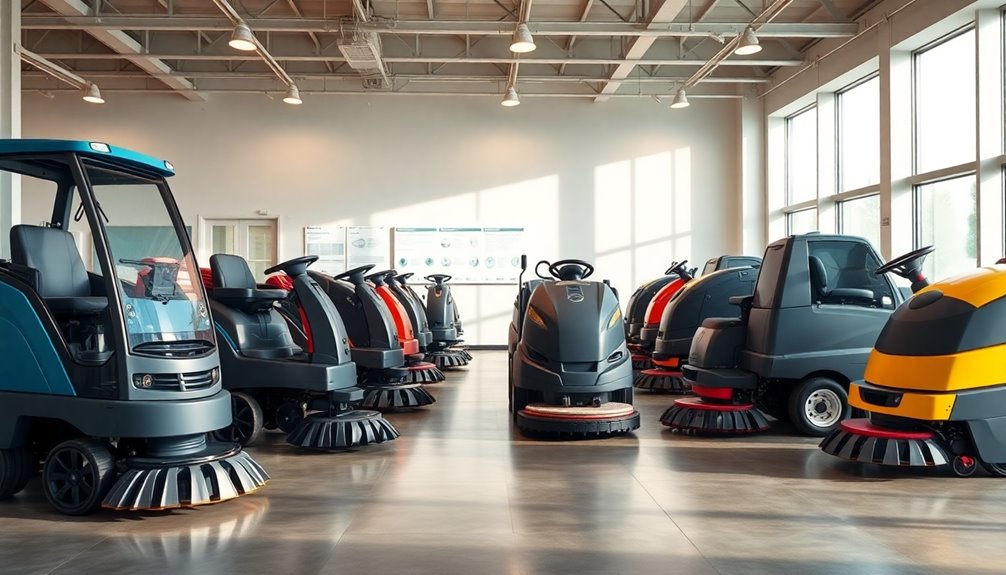
Commercial sweepers play an essential role in maintaining cleanliness in various industrial settings.
You'll find two main types: walk-behind sweepers and ride-on sweepers. Walk-behind models are perfect for areas under 4,000 sq. ft., allowing you to navigate narrow aisles effectively. On the other hand, ride-on sweepers excel in larger spaces like warehouses, thanks to their powerful motors that boost cleaning efficiency.
When choosing a commercial sweeper, consider its power source—electric, battery-powered, or gas-powered—as each affects mobility and noise levels.
Additionally, look at the hopper capacity; larger bins reduce downtime during cleaning.
Finally, assess the types of debris you'll tackle to guarantee you select the right model for your specific cleaning needs.
Walk-Behind Sweepers: Features and Benefits
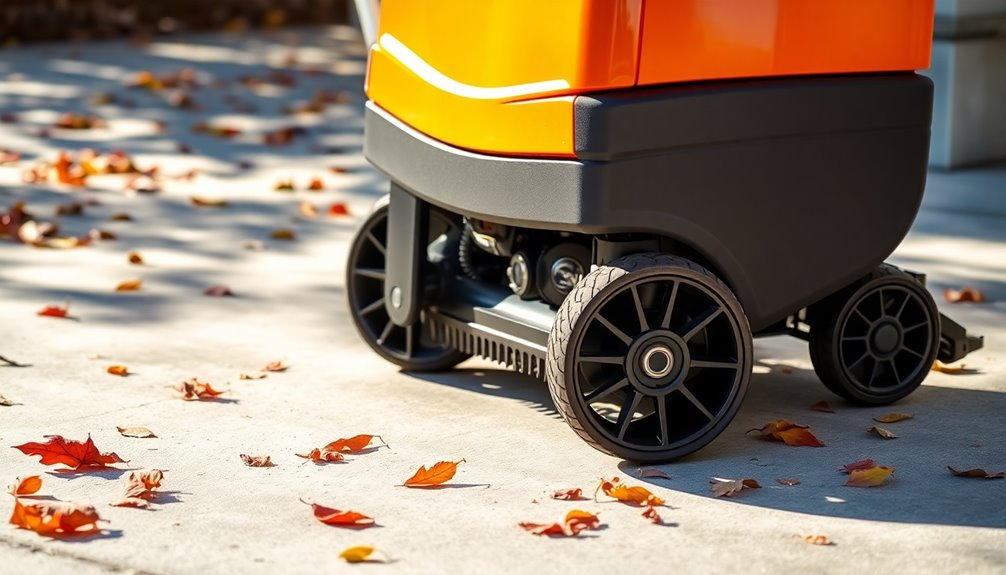
Walk-behind sweepers are perfect for small spaces, making them a smart choice for your retail shop or office.
Their compact design not only allows for easy storage but also enhances maneuverability in tight areas.
Plus, they offer a cost-effective cleaning solution without sacrificing performance, so you can keep your space tidy without breaking the bank.
Compact Design Advantages
When you need to clean compact spaces efficiently, choosing a walk-behind sweeper can make all the difference.
These machines excel in areas under 4,000 sq. ft., making them perfect for warehouses, retail spaces, and offices. Their compact design offers excellent maneuverability, allowing you to navigate tight aisles and congested environments with ease, enhancing your cleaning efficiency.
Equipped with rotary brushes and vacuum systems, walk-behind sweepers guarantee thorough cleaning by lifting both heavier debris and finer particles.
Many models are battery-powered, providing a quieter, more environmentally friendly operation. Plus, features like adjustable handles and easy-to-empty debris containers improve operational convenience, making your cleaning tasks less of a chore and more effective.
Ideal for Small Spaces
For spaces where every square foot counts, these compact sweepers shine in their ability to tackle cleaning challenges efficiently. Walk-behind sweepers are ideal for small spaces like warehouses, retail areas, and offices under 4,000 sq. ft. They're manually operated, offering excellent maneuverability in tight spots. Equipped with rotary brushes and vacuum systems, these floor sweepers come ready to collect both heavier debris and fine dust particles, ensuring a thorough clean. Battery-powered options add the benefit of quieter operation without the need for outlets.
| Feature | Benefit |
|---|---|
| Manually Operated | Great maneuverability |
| Rotary Brushes | Effectively handles debris |
| Battery-Powered Options | Quieter and more mobile |
With models like the S680 and S880, daily cleaning tasks become a breeze.
Cost-Effective Cleaning Solution
If you're looking for an efficient way to keep your small to medium-sized commercial space clean, walk-behind sweepers present a cost-effective solution.
Ideal for areas under 4,000 sq. ft., these machines utilize rotary brushes and vacuum systems to collect larger debris and finer particles, ensuring thorough cleaning.
Their compact design enhances maneuverability, allowing you to navigate tight spaces and narrow aisles with ease.
Battery-powered models offer quieter operation and environmental benefits, enabling flexible indoor cleaning without being tethered to an outlet.
Plus, regular maintenance is simple and the operational costs are low, making walk-behind sweepers a sustainable choice for businesses focused on keeping their commercial spaces clean and efficient.
Ride-On Sweepers: Power and Efficiency
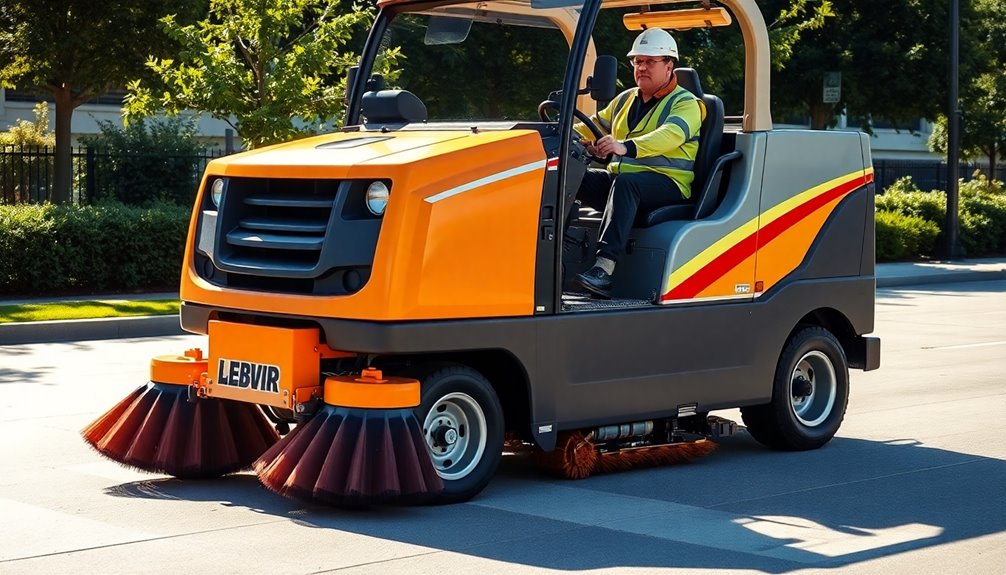
Ride-on sweepers deliver unmatched power and efficiency, making them the perfect choice for cleaning expansive spaces over 4,000 sq. ft., like warehouses and manufacturing facilities.
Equipped with powerful motors, these machines efficiently cover large areas while offering higher debris capacity than walk-behind models. You can enjoy extended cleaning sessions without frequent interruptions for emptying.
Many ride-on sweepers feature advanced suction systems and rotary brushes, ensuring efficient cleaning by lifting both fine dust and larger debris.
If you prefer a quieter option, battery-powered models provide an environmentally friendly alternative, ideal for indoor use in sensitive environments.
With options like the S20, S680, and S880, you've got flexibility and high performance to meet various commercial cleaning needs.
Key Cleaning Mechanisms in Sweepers
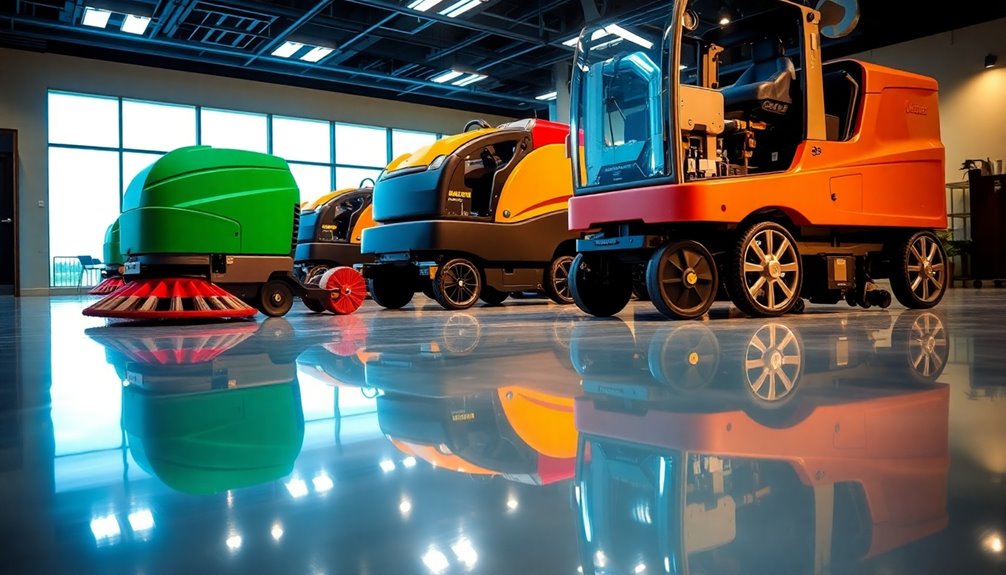
When it comes to effective cleaning, commercial sweepers rely on key mechanisms that enhance their performance. These machines utilize rotary brushes that rotate to lift and collect dirt and debris, making them perfect for heavier materials. Many models feature vacuum systems that capture finer particles, often equipped with HEPA filters to improve air quality. This combination guarantees thorough cleaning, effectively removing both large debris and fine dust.
| Mechanism | Description |
|---|---|
| Rotary Brushes | Rotate to lift and collect dirt and debris |
| Vacuum Systems | Utilize suction to capture finer particles |
| HEPA Filters | Enhance air quality by trapping dust and allergens |
| Brush Size | Influences the area covered in a single pass |
| Suction Power | Determines the strength of debris collection |
Selecting the Right Sweeper for Your Facility
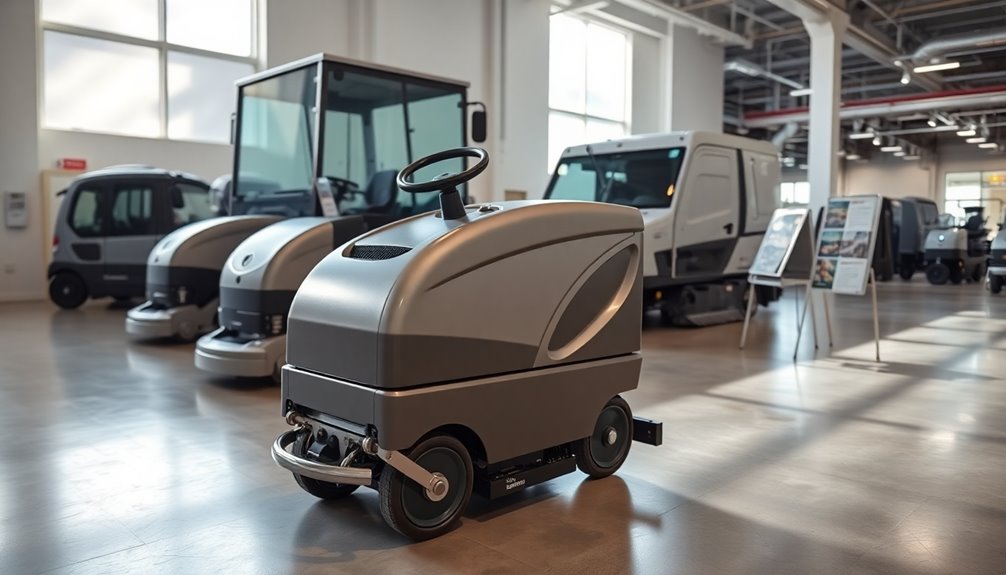
How do you choose the right sweeper for your facility? Start by considering the size of your space. For areas under 4,000 sq. ft., walk-behind floor sweepers are perfect, while larger commercial spaces, like warehouses, benefit from ride-on models.
Next, assess the type of debris you deal with; heavy debris needs a sweeper with stiffer brushes, while lighter dust can be managed with vacuum systems. Maneuverability is vital—walk-behind sweepers excel in tight spaces.
Finally, think about cleaning efficiency; models like the SW28R can cover up to 97,950 sq. ft/hr. Don't forget to choose a power type that suits your needs—battery-powered sweepers offer mobility and quieter operation, essential for many facilities.
Understanding Power Source Options
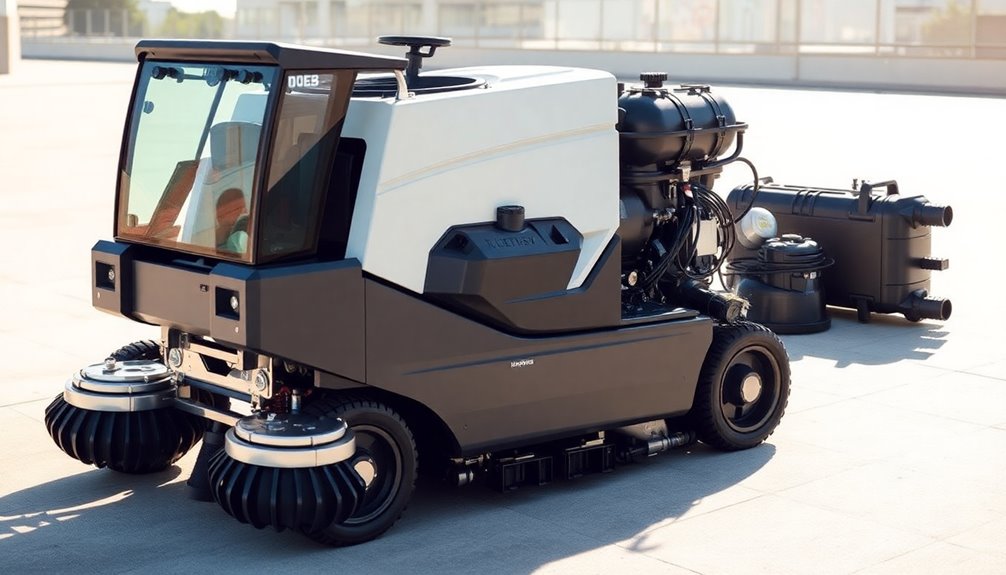
When choosing a commercial sweeper, the power source plays a vital role in its performance.
Electric sweepers shine in indoor settings, while battery-powered models offer flexibility and quiet operation.
If you're tackling large outdoor spaces, gas-powered options provide the robust performance you need.
Electric Power Advantages
Electric-powered sweepers stand out as an excellent choice for those seeking efficiency and convenience in their cleaning operations.
These electric sweepers provide consistent performance, making them ideal for indoor use, especially in warehouses and retail spaces where access to outlets is available.
With lower operational costs compared to gas models, you'll find that electricity is typically cheaper and requires less maintenance.
Plus, electric sweepers operate quietly, promoting noise reduction in sensitive environments like offices and hospitals.
Their lighter, more maneuverable design makes maneuvering confined spaces easier.
Many electric models come equipped with advanced filtration systems, including HEPA filters, ensuring effective dust control and improved air quality in your cleaning environment.
Battery-Powered Flexibility
While considering power source options for your cleaning needs, battery-powered sweepers offer an impressive level of flexibility.
These machines excel in larger spaces like warehouses and retail environments, providing greater mobility since you won't need to access power outlets. Operating quietly, they're perfect for noise-sensitive areas, allowing you to clean without disrupting business.
Additionally, battery-powered models are typically more environmentally friendly, producing zero emissions and reducing your carbon footprint.
With efficient battery life ranging from 4 to 8 hours of continuous use, you can rely on them for extended cleaning sessions.
Models like the S680 and S880 even balance compact design with the benefits of battery power, making them ideal for smaller retail spaces. Furthermore, their design contributes to environmental sustainability, aligning with the growing emphasis on reducing overall carbon emissions.
Gas-Powered Performance
For those tackling outdoor cleaning tasks or managing large areas, gas-powered sweepers stand out with their robust performance.
These machines feature larger engines that excel in handling heavier debris, making them perfect for outdoor applications like construction sites and parking lots.
In industrial settings, their ability to operate in rugged environments without needing an outlet is a significant advantage.
With a longer operational range than electric models, you can enjoy extended cleaning sessions without interruptions.
However, be mindful that gas-powered sweepers may produce higher noise levels and emissions, which can limit their use in indoor spaces or environmentally sensitive areas.
Assessing Cleaning Efficiency and Capacity
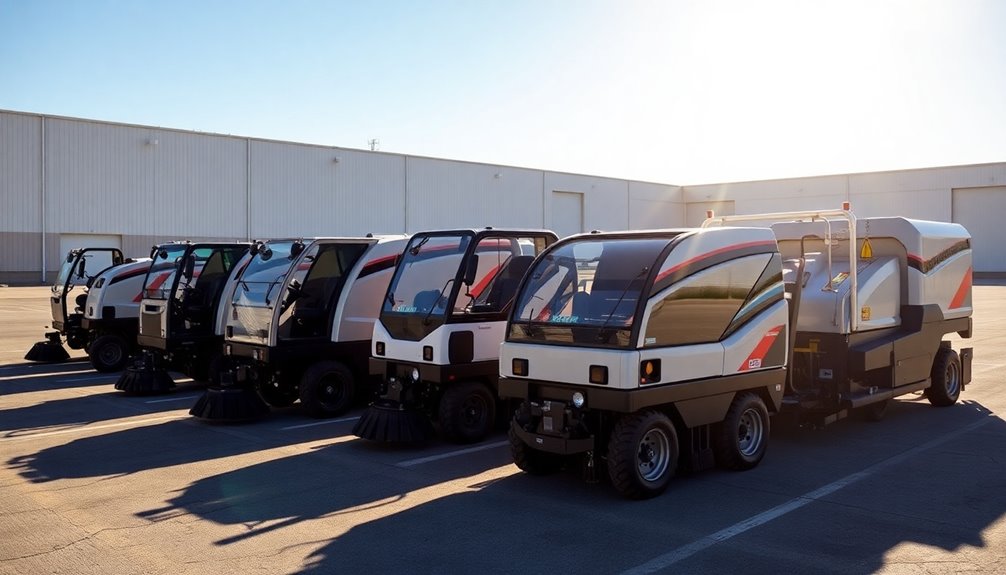
When evaluating the cleaning efficiency and capacity of commercial sweeper machines, it's essential to take into account factors such as model type, brush size, and suction power.
Walk-behind sweepers typically clean areas between 24,490 sq ft/hr to 54,900 sq ft/hr, making them great for small to medium spaces. In contrast, ride-on models like the SW28R excel with cleaning productivity rates up to 97,950 sq ft/hr, perfect for large industrial environments.
The choice of a heavy-duty brush can enhance cleaning efficiency for tough debris, while softer brushes cater to delicate surfaces. Additionally, regular maintenance, especially inspecting and replacing brushes, directly influences the machine's hopper capacity and overall cleaning effectiveness.
Indoor Vs Outdoor Sweepers: Key Differences
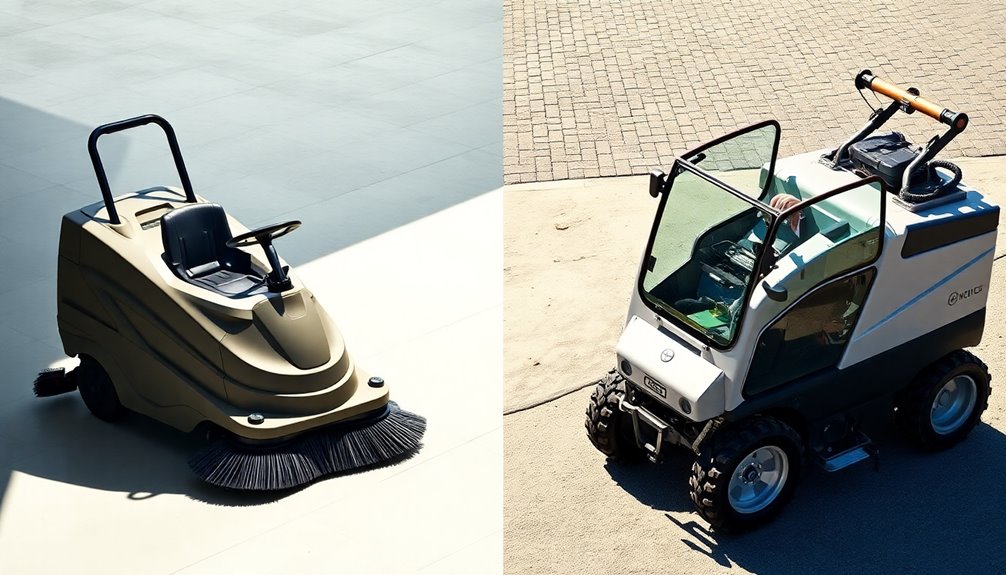
Understanding the differences between indoor and outdoor sweepers is essential for selecting the right machine for your cleaning needs.
Indoor sweepers are tailored for smooth surfaces like tile and carpet, focusing on fine debris collection with vacuum systems. They prioritize quiet operation and enhanced maneuverability to navigate tight spaces in warehouses or retail stores.
In contrast, outdoor sweepers are built for rough terrains, handling larger debris in areas like parking lots and streets. They feature larger debris bins to accommodate greater volumes of waste and are designed for speed and efficiency.
Recognizing these distinctions helps guarantee superior performance, whether you're cleaning indoor environments or tackling outdoor challenges.
Maintenance Considerations for Commercial Sweepers
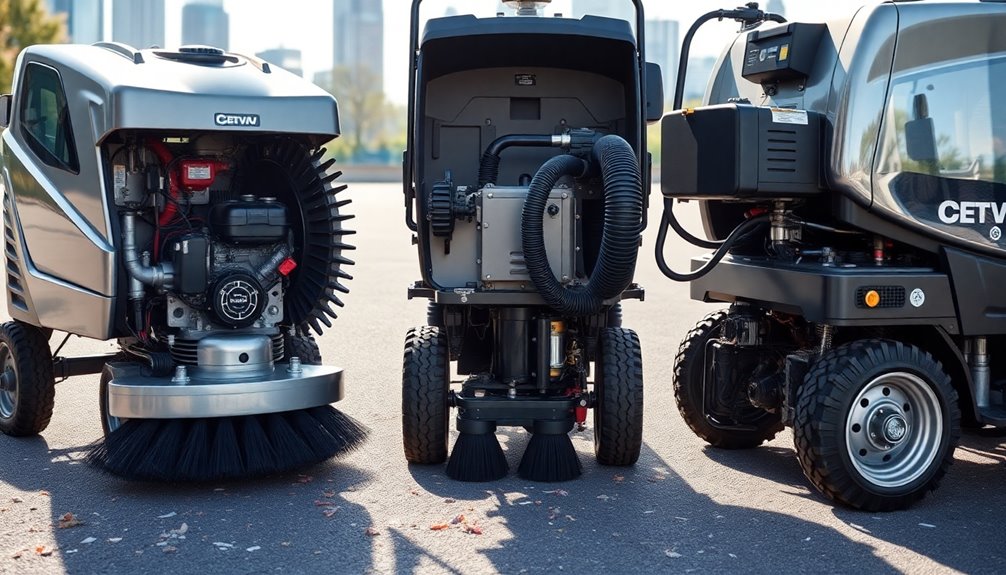
Regular maintenance is crucial to keeping your commercial sweeper running efficiently and extending its lifespan. By tracking service intervals in a maintenance log, you can manage brush replacements and scheduled cleaning effectively. Proper airflow and dust capture are essential for peak performance, so make certain the suction system and filters receive regular attention.
| Maintenance Task | Frequency | Notes |
|---|---|---|
| Brush Replacements | As needed | Tool-free options available |
| Suction System Cleaning | Monthly | Guarantees efficient operation |
| Filter Inspection | Every 3 months | Maintain air quality |
| General Inspection | Weekly | Identify issues early |
| Staff Training | Annually | Enhance operational efficiency |
Training your operators in proper procedures minimizes wear and tear, maximizing productivity.
Frequently Asked Questions
What Are the Different Types of Sweepers?
When you're choosing a sweeper, consider the different types available.
You've got walk-behind models, which are great for smaller spaces, and ride-on ones, perfect for larger areas.
If you're dealing with rugs, a carpet sweeper might be your best bet, while magnetic sweepers work wonders for metal debris.
For outdoor tasks, look for sweepers designed for rough terrains.
Each type serves unique cleaning needs, so pick one that fits your situation.
How Many Types of Floor Cleaning Machines Are There?
There are several types of floor cleaning machines available, each designed for specific tasks.
You'll find walk-behind sweepers perfect for smaller spaces, while ride-on sweepers tackle larger areas efficiently.
Additionally, carpet sweepers focus on lifting dirt from carpets, and magnetic sweepers collect metal debris.
Other machines, like floor scrubbers, burnishers, and vacuum cleaners, cater to various surfaces and cleaning needs, ensuring you have the right tool for any job.
What Is the Difference Between a Scrubber and a Sweeper?
A scrubber and a sweeper serve different cleaning needs.
If you're tackling stubborn stains on hard surfaces, a scrubber's your go-to. It uses water and cleaning solutions, making it perfect for deep cleaning.
On the other hand, if you need to quickly collect dust and debris, a sweeper's efficiency shines. It handles both light and heavy debris and covers large areas faster, making it ideal for warehouses or outdoor spaces.
Choose based on your cleaning task!
What Is a Commercial Sweeper?
Did you know that some commercial sweepers can clean up to 97,950 square feet per hour?
A commercial sweeper is a powerful, mechanical device designed to efficiently remove dirt and debris from various surfaces in industrial and commercial settings.
These machines often feature rotary brushes and suction systems, making them effective for both heavy debris and fine particles.
Regular maintenance is key to keeping your sweeper running at its best and extending its lifespan.
Conclusion
To summarize, choosing the right commercial sweeper isn't just about the machine itself; it's about understanding your facility's unique needs. While some believe ride-on sweepers are always more efficient, walk-behinds can excel in tighter spaces. Your cleaning goals, space layout, and maintenance capabilities all play a role in the decision. By considering these factors and exploring different models, you can guarantee you select a sweeper that keeps your environment clean and efficient.
